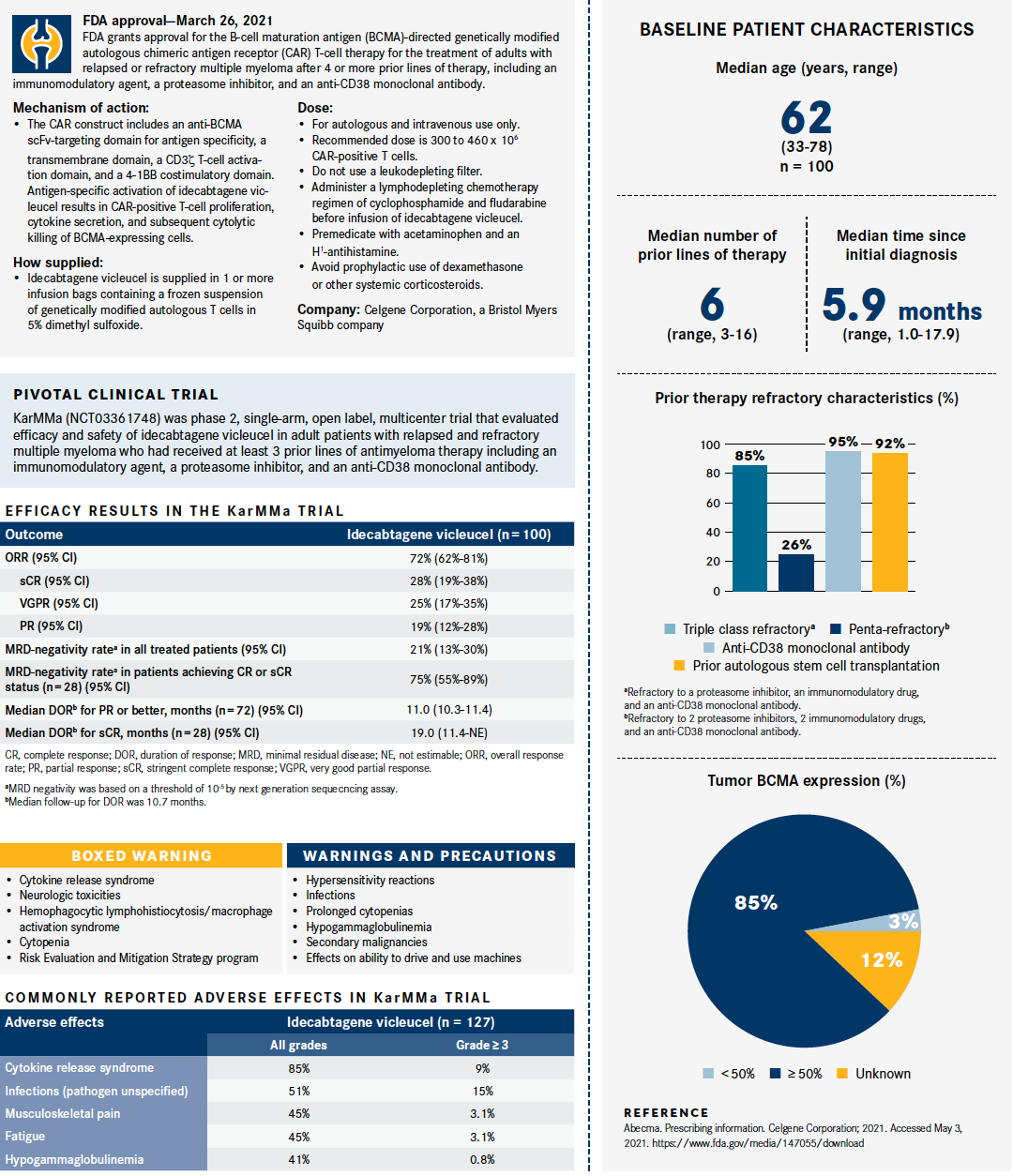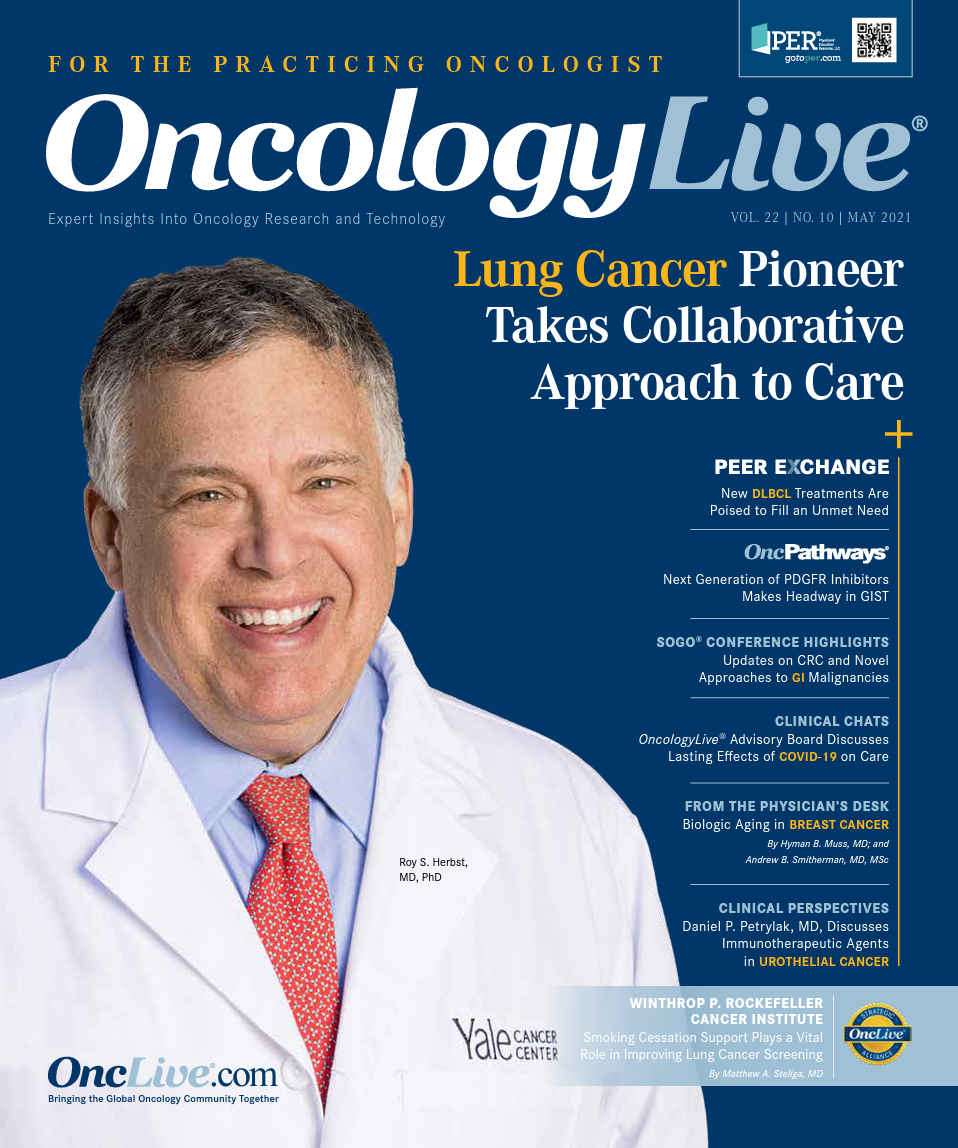Publication
Article
Oncology Live®
Ide-Cel Proves Highly Effective in Relapsed/Refractory Myeloma
Author(s):
Nikhil C. Munshi, MD, discusses how idecabtagene vicleucel has potentially marked the beginning of a new chapter for cellular therapy in multiple myeloma.
Nikhil C. Munshi, MD

Patients with relapsed or refractory multiple myeloma (MM) have another later-line treatment option following the FDA approval of idecabtagene vicleucel (ide-cel; Abecma). Specifically, the chimeric antigen receptor (CAR) T-cell therapy is indicated for patients after 4 or more prior lines of therapy, including an immunomodulatory agent, a proteasome inhibitor, and an anti-CD38 monoclonal antibody.1
Ide-cel was investigated in the phase 2 KarMMa trial (NCT03361748), in which 127 adult patients with MM who had received at least 3 prior treatments were given ide-cel across a dose range of 150 to 518 x 106 CAR-positive T cells. The median duration of follow-up was 11.4 months. In the evaluable efficacy population (n = 100) of patients who received 300 to 460 x 106 CAR-positive T cells, the overall response rate (ORR) was 72% (95% CI, 62%-81%), with 28% (95% CI, 19%-38%) achieving a stringent complete response (sCR).2
In an interview with OncLive, Nikhil C. Munshi, MD, professor of medicine at Harvard Medical School, director of basic and correlative science at the Jerome Lipper Multiple Myeloma Center, and the Kraft Family Chair at Dana-Farber Cancer Institute, all in Boston, Massachusetts, discussed how ide-cel has potentially marked the beginning of a new chapter for cellular therapy in MM.

OncLive: What has been the general response to the approval of ide-cel?
Munshi: It’s wonderful and thrilling. This treatment has been so incredibly effective. When we treated patients, they had a median of 6 lines of [prior] treatment; they almost had everything they could have had. [Ide-cel] works approximately 80% of the time with deep, good responses—we were waiting for its approval so we could offer it. It opens up a new chapter. This is the first real cellular therapy for myeloma. I’m very excited.
Could you provide an overview of the patient population and highlight some of the interesting points of the efficacy data in the KarMMa trial?
The KarMMa trial was designed for patients who had 3 or more previous treatments [including] a proteasome inhibitor, immunomodulator, and anti-CD38 antibodies. The patients also were refractory to their last treatment.
These patients then underwent leukapheresis to collect cells. It takes around 4 weeks to prepare the CAR T cells by genetic modification. During these 4 weeks, one could give bridging therapy, and 88% of the patients got bridging therapy. This tells us that these are [patients with] already advanced, aggressive disease. When the CAR T cells are ready, patients get classic lymphodepletion with fludarabine and cyclophosphamide, get the CAR T cells, and we follow [the patients].
If you look at the patient population of this study, they were a median of 6 years from [receiving a diagnosis] and, more importantly, they had a median of 6 lines of treatment. [Additionally,] 86% were triple-class refractory to the 3 standard treatments and all patients had transplants. One-third to 40% of patients had high-risk disease. In this patient population, the ORR was 72%. If you look at patients who got the target dose of [460 x 106], the response rate was 82%. The median time to response was 1 month, so it was a very quick response even in these advanced patients.
If you look at the number of patients getting CR, at the target dose, it was close to 40% of patients. Within the CR patients, 79% [reached] MRD negativity, so it was quite a deep response. That is why we are so excited, and this is true for all CAR T cells, this is just the beginning. If you look at the standard survival outcomes, the PFS [progression-free survival] overall was 8.8 months. However, patients who got the target dose were close to 12 months and patients with an sCR had a PFS around 20 months. [Overall survival] was 19.4 months, but this is a little bit premature. We will know the real number with a longer follow-up.
What were some of the important findings in terms of safety?
Regarding toxicity, almost every [patient] gets cytokine release syndrome [CRS], but it has been grade 1 or 2. At the target dose, approximately 96% of patients got it. Around 4% to 5% of patients had grade 3. For this product, the time to CRS is 1 day, so it’s very quick and very predictable. It lasts anywhere from 3 to 5 days in most of the patients. Neurotoxicity was 18%, so not a very high number. It’s usually grade 1 or 2; only 3% of patients had grade 3 neurotoxicity.
The other adverse effect we are keeping in mind is cytopenia. I think it’s mainly because of lymphodepletion, not because of the CAR T [therapy], but grade 3 cytopenia occurred in 89% of the patients. The bottom line of this study is that ide-cel provides deep responses, durable responses, and we have a really important and effective option available in these triple-class refractory patients.
Can you expand on the unique advantages this therapy affords patients?
There are 2 parts to this point. One is that it is a one-time treatment, number 2 is that there is no maintenance. In myeloma, except for this treatment, there is no treatment where we don’t give maintenance. Even after transplant, there is an indefinite maintenance. The quality of life is great and if you added maintenance or something else these numbers could even improve.
Patients are going without any treatment for a long duration and that’s very exciting for the patients; they’re really enthused that they are living a normal life.
What are the next steps for ide-cel or CAR T-cell therapy in general in myeloma?
One future advance could be using it at an earlier stage. We have tried using it in the 2-out, 9th-inning setting, and we are getting wonderful responses. We are now leading studies in the second-line and in some cases frontline treatment. [We’re also looking at] new versions of CAR T-cell therapy; [those with] secondary targets that are under investigation and will be important. [Finally, we’re asking] how do we maintain [response]? For example, [can we use] some immunedirected maintenance treatment that keeps it going and functioning? Another [area we are exploring] is the composition of the CAR T cells themselves. Can we enrich for CD4, CD8, or some other types?
Reference
Abecma. Prescribing information. Celgene Corporation; 2021. Accessed May 4, 2021. bit.ly/33kolaY










